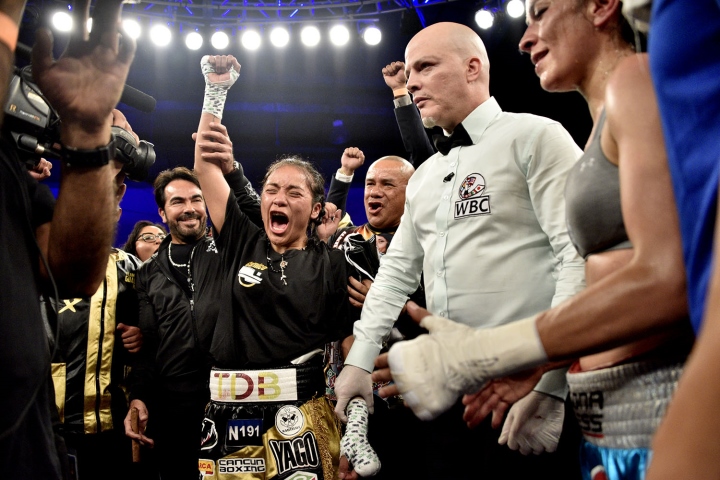In the incandescent world of professional boxing, the shimmering lights often obscure a profound paradox: Why is it that the accolades of female boxers, like those of Guadalupe Martinez, often remain eclipsed by their male counterparts, despite their incredible prowess and determination? Recently, Martinez achieved yet another significant milestone in her career by retaining the WBC title, gracefully overcoming the formidable Irma Garcia. However, the question lingers: why does the narrative still center around male champions, even when women deliver equally scintillating bouts?
As Martinez’s fists danced in the ring, weaving a symphony of jabs and hooks, she not only defended her title; she dismantled the gender bias that pervades the sport. Every punch was a repudiation of the antiquated notion that boxing belongs predominantly to men and, with that bold assertion, emerges an undeniable challenge to the boxing community: are we prepared to embrace an era where female boxers bask in the spotlight as much as their male peers?
The bout against Garcia was not just another contest; it was a theatrical display of resilience and skill. Martinez’s tenacity to not only face her opponent but to do so under the scrutinizing gaze of media and fans alike—with the odds often stacked against her—underscores a narrative much larger than her personal achievements. It speaks to the entire ecosystem of boxing, where the achievements of women are often minimized or overshadowed. In this light, one may ponder: what does it take for a female boxer to be recognized and celebrated with the same fervor as male champions?
Critics and enthusiasts alike must confront the reality of societal conditioning that has long suppressed the visibility of female athletes. It is troubling that even the most skilled women fighters frequently find themselves pigeonholed as novelties rather than legitimate contenders. Nielsen ratings often favor male matches, and promotional budgets rarely mirror the potential market for women’s bouts. Wouldn’t it be a splendid revolution for the audience to demand equality, thereby bolstering the recognition of exceptional athletes like Martinez?
It’s also worth evaluating the media dialogue surrounding female boxers like Martinez. While her victory against Garcia was significant, it was not drowned in the celebratory cacophony typically reserved for male victors. Why must the victory speech of a woman be peppered with disclaimers about the “unusual” nature of her achievement, further perpetuating the stereotype that women are anomalies in the boxing world? This leads us to wonder: what will it take for society to normalize women’s successes and stride forward into a future devoid of the dependency on male validation?
The fight itself was a powerful tableau, where Martinez showcased not merely her technical excellence but also her psychological fortitude. Undoubtedly, she faced the anticipated opposition—not just from Garcia, but from an audience conditioned to expect less from female athletes. Every successful blow from Martinez was not just a point in her favor; it was a statement to aspiring female fighters around the globe: their aspirations can, and should, be valid. Wouldn’t it be a glorious revolution if young girls watched her fight and dared to dream themselves, unfettered by societal limitations?
Yet amidst the jubilation that intelligent boxing aficionados should feel after such a victory, there lies another challenge: the imperative for systemic change. Boxing promotions tend to allocate resources and platforms disproportionately, favoring male athletes while stifling the potential upliftment of women. What kind of future are we crafting when only a select few are heralded? What would happen if boxing organizations began to invest equally in women’s boxing programs, creating a wellspring of talent waiting to erupt?
The challenge before boxing enthusiasts is clear: Are we willing to champion parity in the sport, or will we continue down the road of mediocrity, enshrining male athletes while relegating women to the sidelines? Martinez’s retention of her title brings forth an exciting opportunity to catalyze this crucial conversation. It’s imperative that stakeholders—promoters, media, and fans alike—collectively advocate for a shift. Imagine a sport where female champions receive the same endorsement deals, media attention, and fanfare that male champions take for granted. Wouldn’t that be a thrilling landscape not just for women but for the sport as a whole?
Moreover, as the boxing world grapples with the ramifications of Martinez’s recent success, it’s worth contemplating the ambiguity surrounding female participation in sport at large. Why is it that women are continually measured against their male relatives? Is it so extraordinarily difficult to simply celebrate talent devoid of gender assumptions? Martinez’s triumph should serve as an unwavering beacon for change, beckoning the boxing industry to shed its antiquated notions.
As we reflect on the recent matches and dreams fostered in the corners, it remains vital to engage with the broader implications of female representation in boxing. Guadalupe Martinez stands not merely as a champion but as a vanguard. Will we not only celebrate her victories but also question the pervasive culture surrounding the sport? Are we prepared to rewrite the narratives that have defined boxing for far too long? Perhaps it’s time to put the gloves on and step into the ring—not just as spectators but as advocates for change. The bell has rung; the fight for equality in boxing has only just begun.
